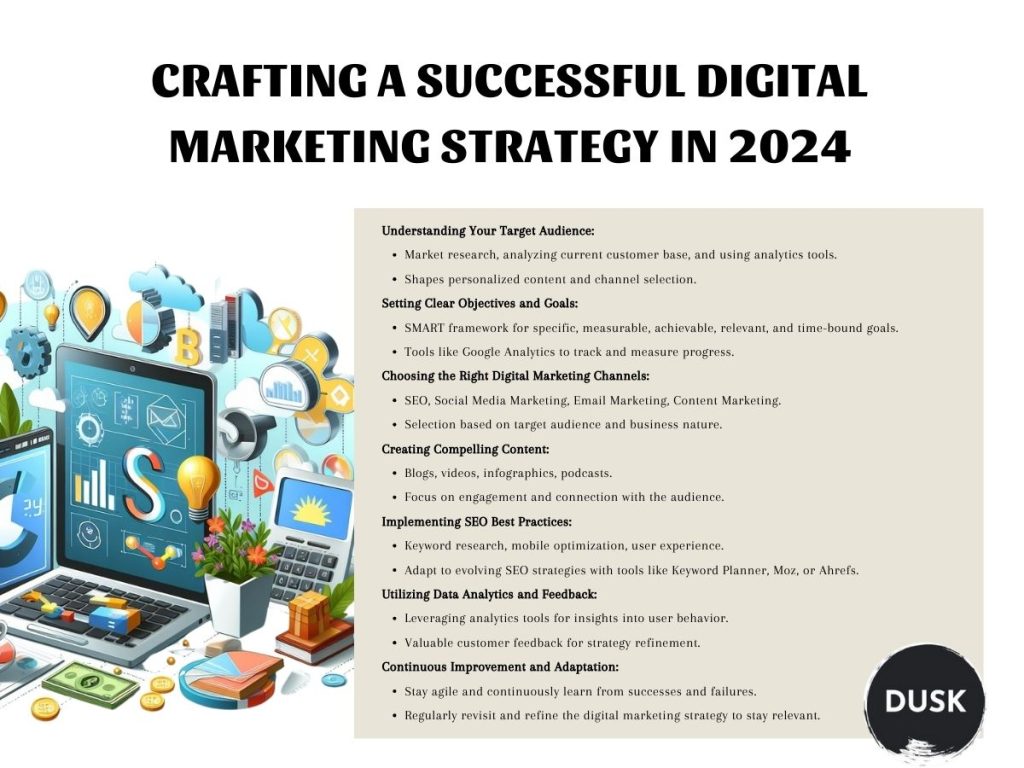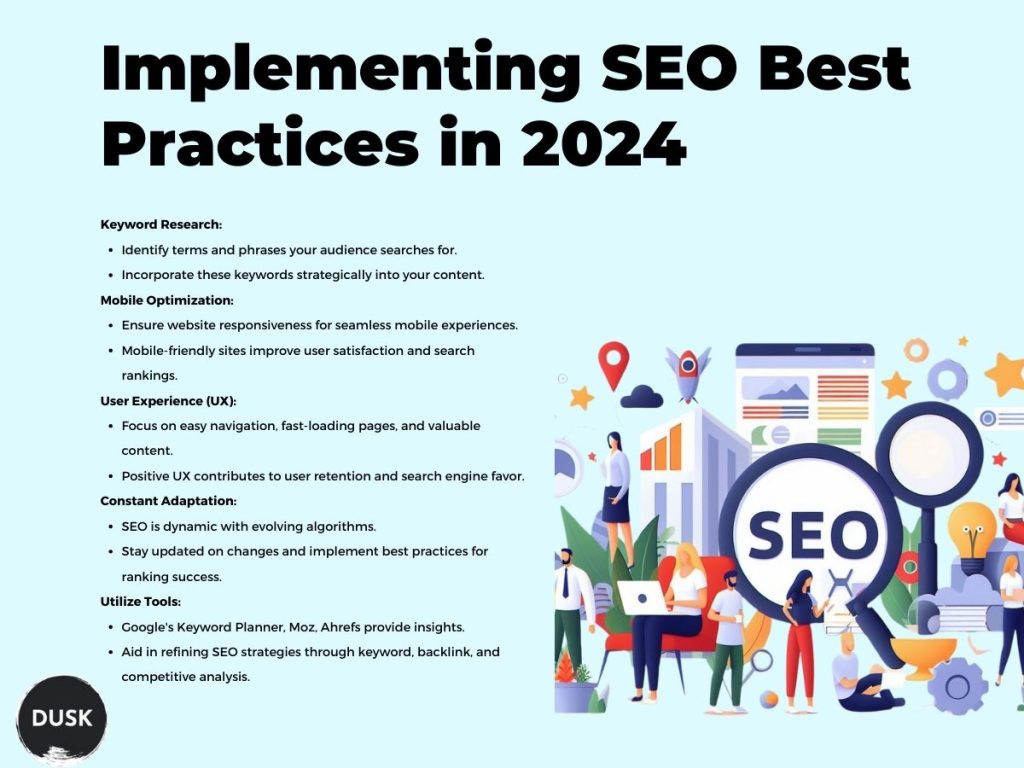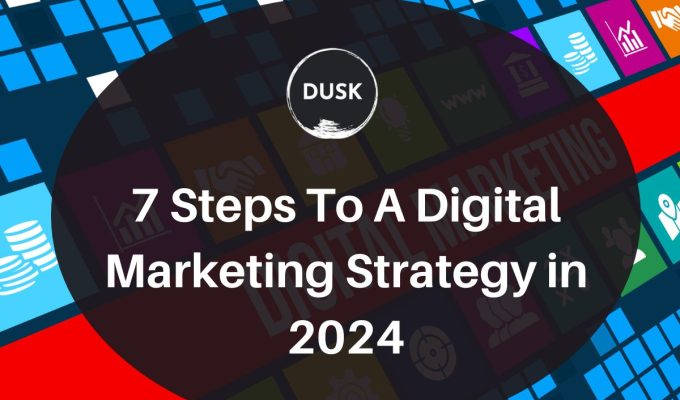As we step into 2024, the digital landscape continues to evolve, presenting new challenges and opportunities for marketers. Crafting a successful digital marketing strategy in this dynamic environment requires not only an understanding of the latest trends but also a flexible and forward-thinking approach.
From leveraging the power of social media to understanding the nuances of SEO, the digital marketing realm is vast and varied. In this blog, we will break down the complex world of digital marketing into 7 actionable steps.
Whether you’re a small business owner or a seasoned marketer, these insights will help you navigate the digital world in 2024 with confidence and creativity.

- Understanding Your Target Audience
The first and arguably most critical step in digital marketing is understanding your target audience. This process involves several key steps:
- Market Research: Conduct thorough research to understand the needs, preferences, and behaviors of your potential customers. This can be achieved through surveys, focus groups, and studying market trends.
- Analyzing Current Customer Base: Look at your existing customers to identify common characteristics and patterns. This analysis can offer insights into who your products or services appeal to and why.
- Using Analytics Tools: Leverage tools like Google Analytics to gain deeper insights into who is visiting your website, their demographics, how they are interacting with your content, and what drives their engagement.
Understanding your audience is pivotal as it shapes every aspect of your digital marketing strategy, from the creation of personalized content to the selection of the right channels to reach them.
This deep understanding allows you to tailor your campaigns to match your audience’s specific needs and preferences, significantly enhancing the effectiveness of your marketing efforts.
For businesses looking to refine their understanding of their target audience, considering a digital marketing analysis tool or consultancy service can provide valuable insights and guidance.
- Setting Clear Objectives and Goals
A successful digital marketing strategy is built on clear, achievable objectives and goals. Setting these goals involves the SMART framework:
- Specific: Define precise targets, such as increasing website traffic by 30%.
- Measurable: Establish metrics to track progress, such as website visits, conversion rates, or social media engagement.
- Achievable: Set realistic goals that challenge your team but are attainable.
- Relevant: Ensure your goals align with your business objectives and market realities.
- Time-bound: Assign deadlines to your goals for timely achievement and assessment.
Examples of digital marketing goals could include increasing website traffic, improving conversion rates, enhancing customer engagement on social media, or boosting brand awareness.
Once these goals are set, employing tools to track and measure progress is crucial. Tools like Google Analytics, SEMrush, or social media analytics platforms can provide valuable data on how your marketing efforts are performing, allowing you to adjust your strategies for optimal results.
- Choosing the Right Digital Marketing Channels
The digital marketing landscape offers a plethora of channels, each with its unique strengths and audience. The key lies in selecting the right mix of channels that align with your target audience and your set goals. The primary channels include:
- Search Engine Optimization (SEO): Optimizing your website and content to rank higher in search engine results pages (SERPs), thus increasing visibility and organic traffic.
- Social Media Marketing: Using platforms like Facebook, Instagram, Twitter, and LinkedIn to engage with your audience, promote your brand, and drive traffic to your website.
- Email Marketing: Sending targeted and personalized messages to a curated list of email subscribers to inform, engage, and convert.
- Content Marketing: Creating and distributing valuable, relevant, and consistent content to attract and retain a clearly defined audience.
The selection of channels should be based on where your target audience spends their time and the nature of your business. For example, a B2B company might find more value in LinkedIn and email marketing, while a B2C company might focus on Instagram and Facebook.
Integrating multiple channels into a cohesive strategy can amplify your reach and effectiveness. For instance, content created for your website can be promoted on social media, and the traction it gains can be used to nurture leads through email marketing.
- Creating Compelling Content
Content is the lifeblood of digital marketing. It’s not just about broadcasting information; it’s about engaging and connecting with your audience. The types of content you can leverage include:
- Blogs: Provide valuable information, establish thought leadership, and improve SEO.
- Videos: Offer an engaging way to showcase products, tell stories, or share testimonials.
- Infographics: Present complex data in a visually appealing and easy-to-understand format.
- Podcasts: Engage audiences with informative and entertaining discussions.
Creating content that resonates with your audience requires understanding their interests, challenges, and preferences. It’s about creating value – whether that’s through educating, entertaining, or inspiring your audience. High-quality, relevant content can set you apart from competitors and establish your brand as an authority in your field.
Businesses should consider employing a content creation service or utilizing a content marketing tool to streamline their content creation process. These services can offer expertise in crafting content that not only engages your audience but also aligns with SEO best practices to enhance visibility.
- Implementing SEO Best Practices
SEO is an integral part of digital marketing, ensuring your content is visible and reachable to your target audience. In 2024, key SEO strategies include:

- Keyword Research: Identify the terms and phrases your target audience is searching for and incorporate them into your content.
- Mobile Optimization: Ensure your website is responsive and offers a seamless experience on mobile devices.
- User Experience (UX): Focus on creating a website that is easy to navigate, fast-loading, and provides valuable content.
SEO is a constantly evolving field, with search engine algorithms continually updating. Staying abreast of these changes and implementing best practices is essential to maintain and improve your website’s ranking in search results.
Tools like Google’s Keyword Planner, Moz, or Ahrefs can provide valuable insights into keywords, backlinks, and competitive analysis, helping you refine your SEO strategies.
- Utilizing Data Analytics and Feedback
Data is a goldmine for digital marketers. It informs strategy, offers insights into consumer behavior, and helps measure the effectiveness of marketing efforts.
Analytics tools like Google Analytics, Adobe Analytics, or social media analytics platforms provide a wealth of information on user behavior, traffic sources, engagement metrics, and more. This data allows marketers to make informed decisions, tailor their strategies, and optimize campaigns for better results.
Additionally, customer feedback, whether through surveys, social media interactions, or reviews, offers invaluable insights. Listening to your audience and adapting your strategy based on their feedback can lead to improved customer satisfaction and loyalty.
- Continuous Improvement and Adaptation
The digital marketing landscape is dynamic, with new trends, technologies, and consumer behaviors emerging constantly. A successful digital marketer is one who is agile, continuously learning, and adapting. This involves analyzing what works and what doesn’t, learning from both successes and failures and staying updated with industry trends and best practices.
Regularly revisiting and refining your digital marketing strategy is crucial. It’s about evolving with your audience and the market, ensuring that your marketing efforts remain effective and relevant.
Tips and Best Practices for Creating a Content Calendar
A well-structured content calendar is crucial for any digital marketing strategy. It ensures consistency, aids in targeting your audience effectively, and aligns with your marketing goals. Remember to be flexible, monitor trends, and adjust your content accordingly.
By incorporating the insights from the 7 steps of digital marketing strategy, your content calendar will not only be organized but also highly effective in engaging your audience in 2024.
Frequently Asked Questions (FAQs) – Dusk Digital
- What are the most effective digital marketing channels in 2024?
The effectiveness of digital marketing channels varies based on your target audience and objectives. Popular channels include social media, SEO, email marketing, and content marketing.
- How often should I update my digital marketing strategy?
Regularly updating your strategy, at least quarterly, is essential to respond to market trends and customer feedback.
- What are the best tools for measuring digital marketing success?
Google Analytics, SEMrush, and HubSpot are widely used for measuring digital marketing success, offering insights into traffic, engagement, and conversion metrics.
- How can small businesses compete in digital marketing with limited budgets?
Small businesses can focus on niche markets, leverage cost-effective channels like social media, and create high-quality, engaging content to effectively compete in digital marketing.






